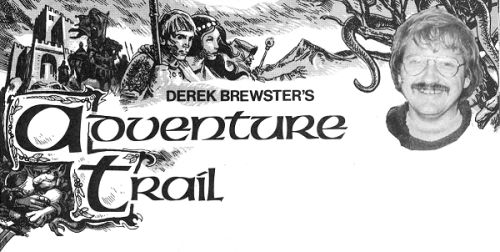

You know, when I buy a piece of software, or have it dropped through my letterbox, I expect the packaging and instruction leaflet to inform me on why this game exists and why it should merit my attention. Gilsoft’s The Curse has a sparse cover which give more prominence to copyright and warning notices than to the substance of the program. One can only assume there is nothing worth mentioning and so what impression does this give? It hardly augurs well. Indeed, the cover supplies the name of the artist who decorated the inlay but there is no mention of the author of the program itself. Don’t get me wrong about artwork, certainly packaging should have good artwork but this must reflect the quality of the program within, and not exceed it. The artistic details of Tower of Despair shows how artwork can add appreciably to the atmosphere and enjoyment of an adventure. But surely the software business has much in common with the music industry; the public will remain loyal to good programmers and seek out quality from whichever quarter it emanates just as loyalties to artists and the unearthing of excellence goes on even in the music world.
Packaging and leaflets provide the room for two important aspects, the storyline and instructions. A storyline mustn’t be so small as to fit in the window at the back of a cassette casing but should be full and enlightening enough to ensure a substantive background to develop in the player’s mind before play begins and to encourage a feel for how the game might be tackled. Alas, I have witnessed so many storylines tagged on to a finished program to round off the marketing exercise. It should, of course, be in existence before coding begins so that the plot and theme are integral parts from the off, ensuring a sense of consistency and credibility pervades the whole. Instructions find a natural home on the cassette cover where browsing in a computer store may tell something of the game and should not reside in the program as this would then represent an unforgivable waste of memory (some Quilled games are guilty here) and neither should they reside on the tape before the game proper as this is then a waste of the game player’s time (Knight’s Quest, for example).
All this brings me round to a great and ever-fluctuating debate in software retailing, namely, should the package be large and flamboyant or small and utilitarian. Cynically, a large package is justified by the greater price charged for it, representing a greater capture of the consumer’s money for the software business merry-go-round — packaging, printing, publicity. This last is a significant point as a large package is its own advert. Who can forget Valkyrie 17 in all the shops before Christmas? Perhaps there is a deeper message here, playing on the psychology which has it that if a company has gone to all the trouble of producing a large, expensive package, then what is on the tape must be worth something. Alas, I can think of many examples where this reasoning is misleading. What a large presentation can afford is a suitably glossy booklet giving in-depth playing instructions and a greater insight into the complexities therein. Certainly, no one would complain of the extra expense entailed to this purpose in the Midnight Trilogy. But what of the many where the supporting literature is thin on the ground and the cassette wallows in a sea of moulded plastic? It would seem the packaging here is only a precept for charging more. Unfortunately, you can not tell whether a large package has much supporting literature until you buy it, as shops are reluctant to leave anything on the shelves which might tempt petty thieving.
Well, here is the crux of the matter; I myself, on the whole, prefer cassette-sized packs because they are easier to carry back home and are more utilitarian in a futuristic way. It is similar to my regard for the Spectrum — there is some fascination in a computer with 48K RAM which takes up just a little more room than a pocket calculator and can be unplugged and carried around with the ease of a book. So with cassettes. A world of adventure packed into a small plastic box with neat, precise artwork, and playing instructions unfolding like a concertina. But if large packages grabbed the attention, and the shelf space, over the festive season one development had them cast as dinosaurs. Not only could you allot the big packs a position with the cassette-sized packs neatly stacked in cassette racks and cases, but, when browsing in shops their absence amongst the chart displays was very noticeable — they just could not fit into displays like the Boots Top Twenty!